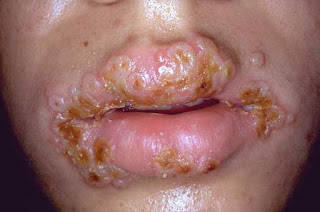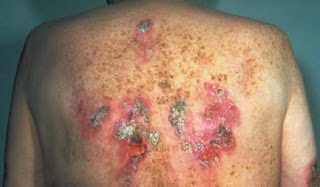Hypertension in Pregnancy
Hypertension in pregnancy is a vascular disorder that occurs before pregnancy or arising in pregnancy or in the early postpartum. However, we discuss in this paper only which arise hypertension during pregnancy. Class of diseases characterized by high blood pressure and sometimes accompanied by proteinuria, edema, convulsi, coma, or other symptoms.
Clinical manifestations for mild hypertension in pregnancy include:
- Diastolic blood pressure less than 100 mmhg.
- Proteinuria fainter until --- +1
- Minimal elevation of liver enzymes
Clinical manifestations to severe hypertension in pregnancy include:
- Diastolic blood pressure of 110 mmHg or more
- Persistent proteinuria + 2 or more
- headache
- Impaired vision
- Upper abdominal pain
- Oliguria
- Convulsions
- Creatinine increased
- Thrombocytopenia
- Increased liver enzymes
- Stunted fetal growth
- Pulmonary edema
Nursing Care Plan for Hypertension in Pregnancy
Nurses need a scientific method in the therapeutic process of the nursing process. The nursing process is used to assist nurses in nursing practice systematic in addressing the existing nursing.
Provision of nursing care is a therapeutic process that involves working relationship with the client, family or community to achieve optimal levels of health.
The Data Collection
The data were collected or studied include:
1. The identity of the patient
In pregnant women aged less than 25 years of incidence tripled. In pregnant women older than 35 years can occur latent hypertension.
Although the proportion of pregnancies with gestational hypertension in the United States in the past decade increased by almost a third. This increase was partly due to an increasing number of older mothers and multiple births. For example, in 1998 the birth rate among women aged 30-44 and the number of births to women age 45 and older are at the highest level in three decades, according to the National Center for Health Statistics. Furthermore, between 1980 and 1998, the rate of twin births increased by about 50 percent overall and 1,000 percent among women ages 45-49; levels of triplet and higher order multiple births jumped more than 400 percent overall and 1,000 percent in among women in their 40s.
2. The main complaint
Patients with hypertension in pregnancy is obtained in the form of complaints such as headaches, especially neck area can even dizzy eyes, eyes blurred, proteinuria (protein in the urine), sensitive to light, painful heartburn.
3. History of present illness
In patients with heart disease, hypertension in pregnancy, usually preceded by signs of easy fatigue, headache (not relieved by common analgesics), diplopia, upper abdominal pain (epigastric), oliguria (less than 400 ml per 24 hours) and nocturia and so on. It should also be asked if the client suffers from diabetes, kidney disease, rheumatoid arthritis, lupus or scleroderma, also need to be asked when the complaints began to appear. What action has been taken to reduce or eliminate these complaints.
4. History of the disease before
It should be asked whether the patient had been suffering from chronic diseases such as hypertension (high blood pressure before becoming pregnant), Obesity, anxiety, angina, dyspnea, orthopnea, hematuria, nocturia, and so on. Mother two times greater risk when pregnant couples who had previously been the father of the pregnancy disease. New couples return risk as primigravida mother. It is necessary to determine possible predisposing factors.
5. Family history of disease
It should be asked whether there are family members who suffer from diseases that are pointed out as the cause of cardiac hypertension in pregnancy. There is a genetic relationship has been investigated. Family history mother or sister increases the risk of four to eight times.
6. Psychosocial History
Includes patient feeling against the disease, how to cope and how the patient's behavior towards the action taken against him.
7. Maternal history
Multiple pregnancies have a greater risk than doubled.
Assessment of Body Systems
B1 (Breathing)
Respiratory include shortness of breath after activity, cough with or without sputum, smoking history, medication use a respirator, additional breath sounds, cyanosis.
B2 (Blood)
Impaired cardiovascular function is basically associated with increased cardiac afterload due to hypertension. In addition there is hemodynamic changes, changes in blood volume in the form of hemoconcentration. Impaired blood clotting time thrombin becomes elongated. The most typical is thrombocytopenia and clotting factor disorders, such as decreased levels of antithrombin III. Circulation includes a history of hypertension, heart disease, coroner, episodes of palpitations, increased blood pressure, tachycardia, sometimes S2 heart sounds heard at the base, S3 and S4, the increase in blood pressure, pulse throbbing clear from the carotid, jugular, radial, tachycardia, valvular stenosis murmur, jugular venous distention, pale skin, cyanosis, cold temperatures.
B3 (Brain)
These lesions are often due to rupture of cerebral blood vessels due to hypertension. Radiological abnormalities of the brain can be demonstrated by CT scan or MRI. The brain can suffer vasogenik edema and hypoperfusion. EEG examination also showed EEG abnormalities, especially after the seizure that can survive in the long seminggu.Integritas ego include anxiety,
depression, euphoria, irritability, tense face muscles, nervous, respiratory heaved, increased speech patterns. Neuro-sensory complaints include headache, throbbing, sub-occipital headache, weakness on one side of the body, visual disturbances (diplopia, blurred vision), epistaxis, increased pressure on cerebral blood vessels.
B4 (Bladder)
History of kidney disease and
diabetes mellitus, history of diuretic drugs also need to be studied. As in other glomerulopathy there is an increased permeability to most of the high molecular weight proteins. Most studies of kidney biopsy showed glomerular capillary endothelial swelling called endoteliosis glomerular capillary. Hemorrhagic necrosis of the liver lobules periporta peripheral section is most likely the cause of increased levels of liver enzymes in the serum.
B5 (Bowel)
Food / liquids include preferred food especially those containing high salt, protein, high fat, and cholesterol, nausea, vomiting, weight changes, edema.
B6 (Bone)
Pain / discomfort include intermittent pain in the limbs, sub-occipital headache severe, abdominal pain, chest pain, heartburn. Security include gait disturbance, paresthesias, postural hypotension.

























